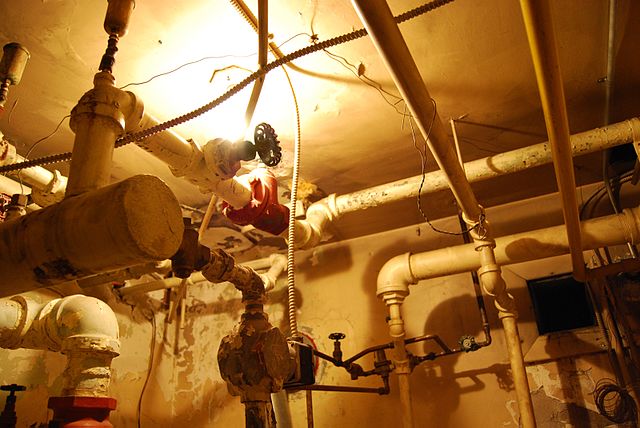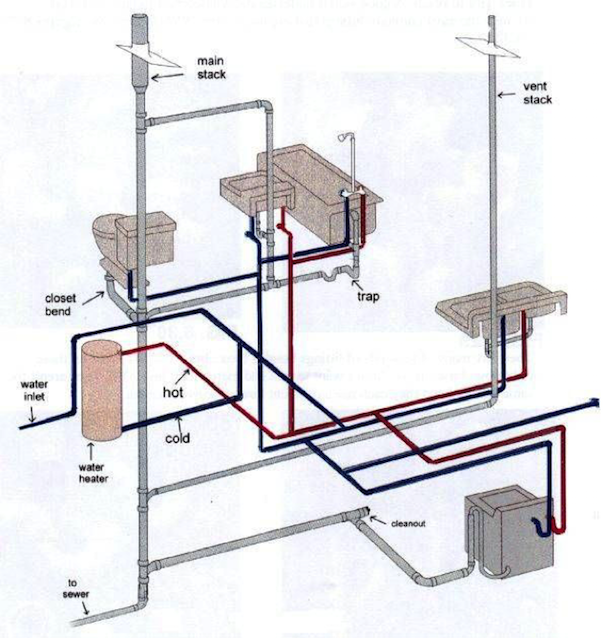What Your House's Plumbing System Works: Structure
Visit HomepageThis post which follows pertaining to Anatomy of a House: Understanding the Components is seriously interesting. Don't bypass it.

Recognizing how your home's plumbing system functions is necessary for every house owner. From delivering tidy water for drinking, food preparation, and bathing to securely eliminating wastewater, a well-maintained pipes system is important for your family members's health and wellness and comfort. In this extensive overview, we'll check out the complex network that comprises your home's pipes and deal suggestions on upkeep, upgrades, and handling typical problems.
Intro
Your home's plumbing system is more than just a network of pipelines; it's an intricate system that ensures you have accessibility to clean water and effective wastewater elimination. Knowing its components and exactly how they interact can help you avoid expensive repairs and make sure everything runs efficiently.
Basic Parts of a Plumbing System
Pipes and Tubes
At the heart of your plumbing system are the pipes and tubing that lug water throughout your home. These can be made from different products such as copper, PVC, or PEX, each with its benefits in regards to resilience and cost-effectiveness.
Fixtures: Sinks, Toilets, Showers, etc.
Fixtures like sinks, bathrooms, showers, and bath tubs are where water is made use of in your home. Understanding exactly how these components link to the pipes system assists in detecting problems and planning upgrades.
Valves and Shut-off Points
Valves manage the flow of water in your plumbing system. Shut-off shutoffs are important throughout emergency situations or when you need to make repair work, allowing you to separate parts of the system without interfering with water circulation to the whole home.
Water System System
Key Water Line
The primary water line attaches your home to the metropolitan water or an exclusive well. It's where water enters your home and is dispersed to numerous components.
Water Meter and Pressure Regulator
The water meter procedures your water usage, while a pressure regulatory authority makes certain that water streams at a risk-free pressure throughout your home's plumbing system, avoiding damage to pipelines and components.
Cold Water vs. Hot Water Lines
Understanding the difference in between cold water lines, which supply water straight from the primary, and hot water lines, which carry warmed water from the water heater, helps in troubleshooting and planning for upgrades.
Water drainage System
Drain Water Lines and Traps
Drain pipes carry wastewater far from sinks, showers, and commodes to the sewage system or septic tank. Catches stop sewer gases from entering your home and additionally catch debris that might create blockages.
Ventilation Pipelines
Ventilation pipelines enable air into the drainage system, preventing suction that might slow water drainage and cause catches to empty. Proper air flow is important for keeping the stability of your pipes system.
Significance of Correct Drain
Making certain proper water drainage stops back-ups and water damage. Regularly cleaning up drains and keeping traps can protect against costly fixings and extend the life of your pipes system.
Water Heating System
Sorts Of Water Heaters
Hot water heater can be tankless or traditional tank-style. Tankless heating units warmth water on demand, while storage tanks save warmed water for prompt use.
Upgrading Your Pipes System
Factors for Upgrading
Upgrading to water-efficient components or replacing old pipelines can boost water high quality, minimize water expenses, and raise the value of your home.
Modern Plumbing Technologies and Their Advantages
Check out modern technologies like clever leakage detectors, water-saving bathrooms, and energy-efficient water heaters that can save cash and reduce environmental effect.
Cost Factors To Consider and ROI
Compute the in advance prices versus long-lasting financial savings when thinking about plumbing upgrades. Lots of upgrades spend for themselves through minimized energy bills and fewer repairs.
Just How Water Heaters Attach to the Pipes System
Recognizing just how water heaters link to both the cold water supply and warm water distribution lines helps in detecting concerns like not enough warm water or leaks.
Upkeep Tips for Water Heaters
Routinely flushing your water heater to remove sediment, checking the temperature level settings, and inspecting for leaks can extend its lifespan and enhance energy efficiency.
Usual Plumbing Problems
Leakages and Their Reasons
Leakages can take place due to aging pipes, loose installations, or high water pressure. Dealing with leakages promptly stops water damage and mold and mildew development.
Blockages and Obstructions
Blockages in drains and toilets are often caused by purging non-flushable items or a build-up of oil and hair. Using drain screens and bearing in mind what decreases your drains pipes can protect against obstructions.
Indicators of Plumbing Troubles to Look For
Low water stress, slow drains pipes, foul odors, or uncommonly high water costs are signs of potential pipes problems that must be addressed immediately.
Pipes Upkeep Tips
Routine Assessments and Checks
Arrange yearly plumbing evaluations to capture problems early. Search for indications of leakages, deterioration, or mineral accumulation in taps and showerheads.
DIY Maintenance Tasks
Straightforward jobs like cleaning tap aerators, checking for commode leaks making use of dye tablet computers, or protecting exposed pipelines in cold environments can avoid significant pipes issues.
When to Call a Specialist Plumber
Know when a plumbing concern calls for professional proficiency. Attempting complex repairs without correct understanding can bring about even more damages and higher repair service costs.
Tips for Reducing Water Usage
Straightforward routines like fixing leaks quickly, taking shorter showers, and running complete lots of laundry and dishes can conserve water and lower your utility costs.
Eco-Friendly Plumbing Options
Consider sustainable pipes products like bamboo for floor covering, which is durable and green, or recycled glass for kitchen counters.
Emergency situation Preparedness
Actions to Take Throughout a Pipes Emergency situation
Know where your shut-off valves are located and how to turn off the supply of water in case of a ruptured pipeline or significant leakage.
Importance of Having Emergency Get In Touches With Handy
Keep get in touch with details for local plumbing technicians or emergency services easily offered for fast response during a plumbing crisis.
Ecological Impact and Conservation
Water-Saving Fixtures and Home Appliances
Mounting low-flow taps, showerheads, and commodes can significantly minimize water use without compromising efficiency.
DIY Emergency Fixes (When Applicable).
Short-term repairs like using duct tape to patch a leaking pipeline or positioning a pail under a leaking faucet can lessen damage till a specialist plumbing technician arrives.
Final thought.
Understanding the composition of your home's plumbing system equips you to keep it effectively, saving money and time on repairs. By following regular maintenance routines and staying notified regarding modern-day pipes modern technologies, you can guarantee your pipes system runs efficiently for many years to come.
HOW YOUR PLUMBING SYSTEM WORKS
Which Pipes Do What?
Blue lines = fresh water supply entering the building Red lines = hot water supply entering the building Grey lines = pipes carrying waste away from the building and venting pipes carrying gases away from the building (through the roof) YOUR MAIN PLUMBING SYSTEMS
There are two main plumbing systems that support your home s basic plumbing needs one that brings clean water into your home, and one that sends dirty water away from your home. Connected to the toilet, bath, shower, and other faucets in your home, these two systems keep your water flowing in the right directions.
ACCESSING FRESH WATER
Fresh and clean water is brought into your home through the main water supply line . Filtered through one pipe, this water is pressured to flow into the various fixtures in your home at any given time.
This water can be sourced from a well located on your property, a pond or river (mostly cottages), or, as in most cases, from the city s municipal water treatment centre. However, it is important to note that water that is untreated, such as the water siphoned from ponds or rivers, may not be safe to drink. Personal water supplies always need to be treated for hardness and contaminants before consumed.
MUNICIPAL WATER SUPPLIES
Improve taste and odour Remove sediment Eliminate hardness Reduce chlorine COLD WATER SUPPLY VS. HOT WATER SUPPLY
Cold water flows into your home or building through the service line, which then distributes hot or cold water to your fixtures. This line is most commonly run through a central column that runs floor to floor. Hot water runs in short and straight pipes as the longer the pipeline, the more heat that will be lost in the transfer. Having shorter pipes also allows residents to access hot water more quickly.
WASTE WATER SYSTEM
Your wastewater system is divided into two parts pipes that send wastewater away from your home and venting pipes that send sewer gas away from your home. Sewage water travels through pipes that flush the water and waste towards local sewers that are operated and managed by your city or town. Most sewer systems rely on gravity to move the wastewater to where it needs to go.
The further away from your toilet or sink, the larger wastewater pipes become. This allows for waste to be disposed of from various parts of your home or business at once without pipe blockages. The angle and flow of these pipes are also essential for keeping your waste pipes clear of build up.
https://harrisplumbing.ca/how-your-home-plumbing-system-works/

We are very involved in The Inner Workings of Your Home's Plumbing and I really hope you liked our blog entry. For those who enjoyed reading our blog post please consider to pass it around. Thanks for your time. Return soon.
Request Service